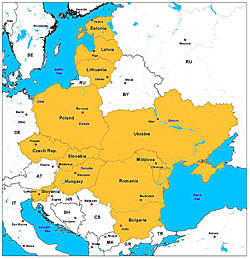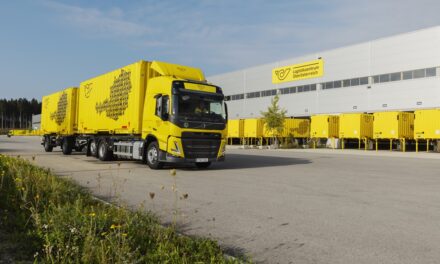
Austrian Post: Becoming a Regional Player
Andreas Dragosits, senior vice president CEE mail at Austrian Post, explains his company’s approach to geographic expansion. Like many other successful expanding companies which are looking for growth potential, Austrian Post has declared that growing in selected markets is one of its key strategies.
Besides its home market, Austrian Post now operates in more than 10 countries in Central and Eastern Europe (CEE) and generates roughly 30% of its revenues abroad.
The contribution of CEE Mail is growing steadily and thanks to recent acquisitions in Poland and Bulgaria this trend is expected to continue.
Positioned
Austrian Post initiated a major restructuring and repositioning programme in the mid-2000s. A thorough market analysis was conducted in order to identify the key developments and movements within postal markets throughout Europe.
Based on this analysis, Austrian Post has positioned its business efforts based on four strategic pillars:
- Defend market leadership (core business) in the home market;
- Growth in selected markets by introducing services upstream and downstream in the value chain and expand geographically with the goal to become “The alternative postal operator” in CEE;
- Enhance efficiency and flexibility of cost structure;
- Strengthen customer orientation and innovation.
Ultimately, the whole development enabled Austrian Post to become one of the very few postal companies in the world to go public. The Initial Public Offering took place in 2006, with slightly less than 50% of the shares traded on the stock market.
In parallel, Austrian Post has now emerged as an internationally operating group which is represented by subsidiaries in more than 10 European countries.
The CEE region: overall strategy

Austrian Post has turned Central and Eastern Europe into its top priority
As mentioned above the second strategic pillar focuses on additional growth, which is to be achieved by expanding the service portfolio relating to “conventional” postal delivery services.
Examples include address management, mailroom, scanning and archiving services.
Along with this growth along the value chain, Austrian Post has also expanded beyond the nation’s borders in order to exploit new growth opportunities, primarily in its core business. Naturally the upcoming liberalisation of the letter mail business was also a decisive factor in our decision making process, with a concentration on Central and Eastern Europe.
The CEE region for an Austrian based company presents an attractive business opportunity. This geographical region, from Poland down to Former Yugoslavia and Bulgaria, has always had a special relationship with Austria and its economy.
This strong historical bond has been shaped over centuries and encouraged Austrian companies to become key investors in the CEE region. This in turn led Austrian Post to the conclusion that it should enter the CEE markets, in keeping with the motto “We follow our customers”.
Austrian Post’s business unit CEE Mail started its expansion path in 2005 with the acquisition of feibra Kft. in Hungary.
CEE Mail is now active through subsidiaries in the letter mail business in Hungary, Slovakia, Croatia, Romania, Poland and Bulgaria.
Three step approach to M&A
Based on the experience of CEE Mail and its in-house partners, a clear approach regarding mergers and acquisitions has been identified.
The process of entering new markets is basically split into three steps:
- Acquisition of market leading private owned postal companies;
- Integration into the Austrian Post Group;
- Development of the core business and adding new business fields, especially distribution of letters below 50g as well as implementation of additional value added services.
CEE Mail continually monitors developments in the CEE countries which are of strategic importance.
The first step when penetrating a new market is to carry out a detailed analysis with respect to the attractiveness of a market. In this regard the main criteria include political and economic stability, legal certainty, size of the market and its potential, and, of course, the competitive situation.
If a market appears to be attractive on the basis of these criteria, the next step is to contact the leading alternative providers of postal services in the target market in order to explore their potential willingness to discuss being acquired by Austrian Post.
Fundamentally, Austrian Post’s preference is to enter a market via an established top player in contrast to a greenfield investment.
After the acquisition has taken place the existing local expertise is fused with the knowhow of an internationally operating group. As well as knowhow, CEE Mail supports the newly acquired company with tools from the expertise gathered in Austria, such as software solutions.
The basic goal is to integrate the acquired company into the Austrian Post Group without suffering major losses of efficiency and flexibility in the existing structure and processes. The challenge is to find the optimal balance between standardising operational and financial driven processes and keeping a high degree of flexibility within the companies acquired.
From a sales perspective, the support intends to connect and link markets on an international level and to enable more effective and efficient market penetration.
Initially, the aim is to strengthen the market position in the respective company’s core market. As a second step additional business fields are added, especially addressed letter mail distribution, based on the strong financial backbone from the core business. In consequence, Austrian Post is investing considerable amounts every year, above and beyond the actual acquisitions costs, in developing and expanding subsidiaries‘ networks and infrastructure, whether in stationary logistics or in the so called last mile, as well as in the implementation of value added services.
Impact of liberalisation
Compared to Western European countries, the growth potential in the medium term in the CEE region is expected to be significantly higher. In this regard, the intention is to exploit the opportunity and potential of these markets and the upcoming liberalisation of the letter mail segment.
Austrian Post considers itself to be a strong regional player which is well networked and has turned this region into its top priority, in contrast to other postal companies which operate on a global basis, or the many others which are just national players.
In any case, the opening of letter mail markets connected to the abolishing of monopolies offers growth opportunities not only for Austrian Post and CEE Mail but also for customers. The establishment of alternative postal providers offers all customers a broader choice among all providers.
One general rule which can be derived from all liberalisation processes which have taken place up until now is that prices tend to decline against the backdrop of an expanded offering and service.
It is expected that a similar development will take place in mail as in the liberalisation of the telecommunications and mobile telephony area: prices significantly declined, and the range of service offerings from which the customers can individually make their choices significantly expanded.
Competition stimulates the market, and this will also be observed in newly liberalised letter mail markets. Liberalisation has already taken place in Slovakia in January 2012, to be followed by almost all other CEE countries in 2013, at least those that are EU member states.
Lessons learned
The CEE region is very often seen as one homogenous region. Of course it is not. The key challenge of managing subsidiaries lies in dealing with differences and diversity.
Austrian Post’s six subsidiaries in six countries represent six different cultures, languages, laws and patterns of thought. Managing this diversity requires a certain sensitivity, respect, close contact and consistent communication. Combining international and local knowhow, learning from each other by choosing the best practice approach, and constant knowhow exchange, represent CEE Mail’s “Eye-Level” approach, which is one of the key success factors in this Austrian Post – CEE Mail – Model.
In the CEE Mail segment Austrian Post intends to expand its market position and become the largest regional postal network by seizing the opportunities created by upcoming liberalisation.
In addition to ongoing efficiency improvements, CEE Mail and its subsidiaries strongly rely on customer and service orientation as well as on new electronic services. All these aspects are combined in the vision of CEE Mail to position its subsidiaries as the main alternative providers next to the respective national postal company.
This article first appeared in the Autumn 2012 edition of Mail & Express Review, the quarterly magazine and sister title of Post&Parcel. For details of how to subscribe to receive future editions of the magazine, click here »












